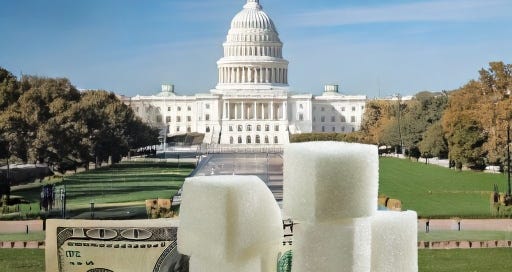Sweetened Politics: The 200-Year History of Sugar Subsidies and Their Bitter Consequences
From the early days of tariff protections in the 1800s to modern-day subsidies and research partnerships, sugar has been shielded and propped up by government policy in a way few other commodities hav
The United States has long had a complicated relationship with sugar. It's a staple in American culture, economy, and politics, yet also a major culprit in one of the country’s most severe public health crises: diabetes. Behind this duality lies a powerful and persistent system of government subsidies, regulations, and market controls that benefit a narrow band of agricultural interests and multinational corporations—often at the expense of consumer health and economic transparency.
From the early days of tariff protections in the 1800s to modern-day subsidies and research partnerships, sugar has been shielded and propped up by government policy in a way few other commodities have. This article traces the rise of sugar subsidies in the United States, examines the industrial web it created, and explores how the same federal government that helped fuel a sugar-fueled health epidemic is now subsidizing the response to it—through diabetes research, treatment funding, and public health campaigns.
The Birth of a Sweet Industry (1800s–1930s)
Sugar first became a significant political and economic player in the United States in the 19th century, when protectionist tariffs were placed on imported sugar to help domestic producers. Initially, sugar cane plantations in Louisiana dominated the American sugar scene, using enslaved labor to produce a highly profitable crop.
By the time of the Civil War, sugar was already seen as an indispensable part of the American economy and diet. The federal government, needing revenue and influenced by domestic producers, enacted tariffs that heavily taxed imported sugar. These protections laid the foundation for a system of federal involvement that persists to this day.
In 1890, the McKinley Tariff Act allowed domestic sugar producers to receive a bounty (essentially an early form of subsidy) while keeping foreign sugar heavily taxed. The Sugar Trust, a conglomerate of sugar refining companies, soon formed, using lobbying and market manipulation to control nearly 98% of sugar refining in the country. In 1911, the U.S. Supreme Court broke up the trust under the Sherman Antitrust Act, but the sugar industry’s political power endured.
The Sugar Act of 1934 and the Creation of Direct Subsidies
Keep reading with a 7-day free trial
Subscribe to ESG University to keep reading this post and get 7 days of free access to the full post archives.





